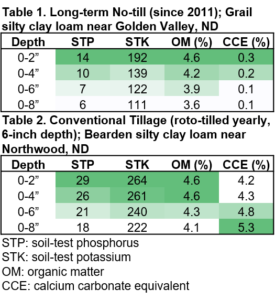Sampling Depth: Be consistent!
This article originally appeared in the AGVISE Laboratories Fall 2022 Newsletter
Soil test results are only as reliable as the soil samples collected in the field. A crucial part of soil sample quality is consistent sampling depth. This is important because all the soil test calibration research and fertilizer guidelines for non-mobile nutrients (e.g., phosphorus, potassium, zinc) are based on a soil core depth of 0-6 inches, thanks to the historical tillage depth. If soil cores are taken too shallow or too deep, you can skew soil test values and the resulting fertilizer guidelines. Getting the most accurate and useful fertilizer guidelines starts with a good quality soil sample. To help illustrate this point, we did a simple demonstration project, showing how soil sampling depth consistency affects soil test results in a long-term no-till and conventional-till field.
Soil nutrient concentrations can vary greatly throughout a soil profile, even more so in long-term no-till where soil nutrients are not regularly mixed. This leads to stratification of nutrients near the soil surface, meaning a soil core that is too shallow or too deep can greatly affect soil test results. You can clearly see the effect of no-till stratification in soil test potassium (STK) levels in Table 1. Between the 0-2 and 0-4 inch soil cores, there is a 53 ppm difference in STK. Although nutrients in conventional tillage systems do not concentrate at the surface to the extent they do in no-till, a concentration gradient still exists. This is most obvious near the tillage depth, where soil mixing below that depth stops. In Table 2, the 0-2 and 0-4 inch soil test results are similar, but the differences become apparent at the 0-6 inch depth. Soil sample depth is just as critical in conventional tillage as it is in no-till. In addition, it is important to collect soil samples before any fall tillage occurs
to collect good quality soil cores with consistent depth. Tillage creates uneven clods and a “fluffy” soil surface, making it hard to determine what actually represents the 0-6 inch soil depth.
Tips to increase soil sample depth consistency
• Collect soil samples before any tillage occurs. If tillage does happen before you can take a soil sample, try to make a firm surface with your foot or sample in a tire track.
• If you are using a hand probe, mark the target soil core depth on the soil probe clearly. A metal file works great to cut a notch in the soil probe at 6 inches. The file mark does not wear away like a piece of tape or permanent marker can.
• If you are using a hydraulic probe and use your hand to measure the soil core length, calibrate often to ensure you are measuring a true 0-6 inch soil core.
• If you train new soil samplers, reiterate the importance of soil sampling depth consistency. Provide clear instructions on measuring the proper soil sampling depth in the field.
• Be sure the soil sample submission information sent to the laboratory (online or paper) matches the actual soil sample depth obtained in the field. The correct soil sample depth can be noted on the paper forms or edited on the AGVISOR online submission before it reaches the laboratory.

